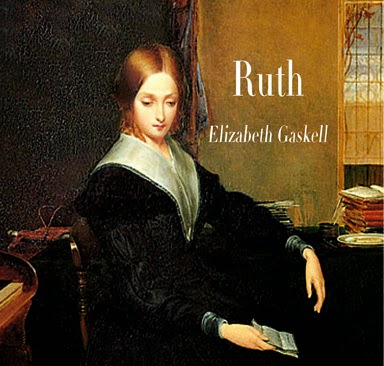Book Review
I am a student of 19th
century English literature and frankly don’t understand the rigid unforgiving
attitude that is displayed toward the sinner, especially a woman who has been presumed
immoral. And if she happened to have a child, in the course of this sin, it will
become a “bastard,” outcast to society.
It seems that repentance was not possible. These people are church going Christians and clergy. I sometimes wonder if the community attitude
was really that severe. I wonder, did
they never read Christ’s story of the woman taken in adultery as they cast
their stones? Did they never preach the
Prodigal Son from the pulpit? Did they
not understand Christ’s teachings of “judge not that ye be not judged? These were my thoughts while Reading Ruth, a beautiful metaphor
for how the atonement works in the life of the repentant sinner.
This is my third
Gaskell. I liked "Mary Barton" a lot and
it’s thesis was forgiveness. “Cousin
Phillips” was my least favorite but I enjoyed the first person narrative with
it’s sweet descriptions of simple rural life and honorable loving people. But “Ruth” wrenched my heart and sent me to
my favorite religious book “The Infinite Atonement” by Tad Callister. I remembered reading how in a sense repentance
can make us better than we would have been had we never sinned. This was the thesis of "Ruth"
“The law of justice brings about order and stability
in the universe. That is good. But the law of repentance does much more; it
brings about godhood. Repentance is more
than a passive process to “get us even” it is the affirmative process to
improve us, refine us, and ultimately perfect us. It’s purpose goes far beyond the satisfaction
of justice. It opens the door to the
cleansing and perfecting power of the Atonement.” (Callister p. 225)
”The Savior’s victory can compensate not only for our
sins but also for our inadequacies; not only for our deliberate mistakes but
also for our sins committed in ignorance, our errors of judgment, and our
unavoidable imperfections. Our ultimate
aspiration is more than being forgiven of sin—we seek to become holy, endowed
affirmatively with Christlike attributes, at one with him, like him. Divine grace is the only source that can
finally fulfill that aspiration, after all we can do.” (Bruce Hafen, Broken Heart, p. 20)
For me, this was Ruth’s story
of redemption. She was an orphan of 16
working as a seamstress in a sweatshop environment. An assignment to repair damaged dresses, at
an elegant ball, introduced her to the handsome, 23 year old, Mr. Bellingham.
He was smitten with her beauty and sought her out, in her realm, on
numerous occasions. He promised to take
her back to her country home for a nostalgic visit on her Sunday off. He didn’t want to be seen with her in a
carriage so they walked. The day was
longer than anticipated. Ruth’s employer
happened to see her on the road and fired her on the spot for being in an
inappropriate situation with this man.
She was distraught and desperate with no place to turn. Ultimately the story unfolds to a seduction
(which we see nothing of) and abandonment in the hills of a resort in Whales. She is pregnant and despondently ill. A deformed minister from a nearby town
sends for his spinster sister and they decide to take her home with them,
passing her off as a widow. This is part
of the conversation that takes place between Mr. Benson and his sister Faith:
“Faith, you know I rejoice in this child’s advent?
“May God forgive, Thurstan!—if you know what you are
saying. But, surely, it is a temptation,
dear Thurstan.”
“I do not think it is a delusion. The sin appears to me to be quite distinct
from it consequences.”
“Sophistry—and a temptation,” said Miss Benson,
decidedly.
“No, it is not.” said her brother, with equal
decision. “In the eye of God, she is
exactly the same as if the life she has led had left no trace behind. We knew her errors before, Faith.”
“Yes, but not this disgrace—this badge of her shame!”
“Faith, Faith! let me beg of you not to speak so of
the little innocent babe, who may be God’s messenger to lead her back to
Him. Think again of her first words—the burst
of nature from her heart! Did she not
turn to God, and enter into a covenant with Him—‘I will be so good?’ Why, it draws her out of herself! If her life has hitherto been self-seeking,
and wickedly thoughtless, here is the very instrument to make her forget
herself, and be thoughtful for another.
Teach her (and God will teach her, if man does not come between) to
reverence her child; and this reverence will shut out sin,--will be
purification.”
And as the story unfolds Ruth is found out and we
see her purification as she turns her life to God through all the
difficulties that come before her, serving others. We
see God give her strength and direction in heart wrenching situations. We see what good people, like the Bensons,
can do for such a lost one as Ruth, even as they are not sure they have done
right. Ruth and her child bring sweetness and love to their unfulfilled lives.
We see others in this story
that throw stones at Ruth, but feel no remorse for their own indiscretions until
they are forced to face them on the home front.
Ruth was ever the willing repentant soul and it shined in her character.
As someone, who believes in
the Atonement of Jesus Christ, this gave me a lot to think about in how the
process works. It is a beautiful story
of faith.




